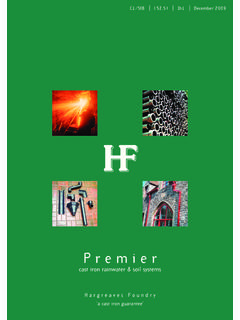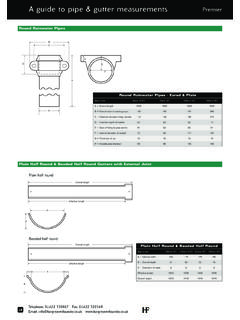Transcription of Cast Iron Production - Hargreaves Foundry
1 cast iron Production The Production of cast iron : Hargreaves Foundry employs traditional sand casting techniques enhanced by modern materials and technology. There are four stages in Production ; Design, Pattern Making, Mould Making and Casting. Design: converting ideas into solid metal requires a planned approach that takes into account the function of the object as well as its appearance. For machine tools the stresses and conditions a machine operates under need to be considered. For architectural purposes it may be structural ability, supportive strength or decorative embellishment. Engineering companies provide detailed, often complex, manufacturing drawings. Architects supply drawings/elevations which in most cases need to be reproduced as manufacturing drawings showing precise dimensions, metal thickness etc so that the next stage, Pattern Making, can progress.
2 Occasionally no plans or drawings exist, especially for conservation and restoration projects where original samples are, however, available. In these cases Hargreaves can use detailed measurements and photographs taken from the originals to make new drawings and patterns for precise reproduction. Pattern Making: once a design has been approved and a manufacturing drawing produced a pattern can be made, normally in wood but sometimes using fibreglass or plastics. Patterns have to be exactly the shape of the finished item and precise in their dimensions as they are used to make the sand moulds. Patterns can be re-used to make more moulds and, if looked after, can last for many years making thousands of moulds. Any irregularity or mistake will be reproduced in the casting. Not only this but patterns must allow for shrinkage of the metal when it cools and also create channels or runners to allow the molten metal to flow into the mould and risers to allow for the escape of gases.
3 It is complex and extremely skilled work and our pattern makers are all apprentice trained and highly experienced. Mould Making: the next stage is to make a mould in sand into which the molten iron can be poured. The pattern is packed into sand that has been mixed with clay or resin and when removed leaves the shape for the casting. Moulds are usually made in two parts and held in boxes for the actual pouring. When the two halves of the mould are placed face to face, one on top of the other, a cavity is created into which the molten iron can be poured. In the case of very large castings these are created in moulds dug out of sand in the Foundry floor. A critical factor in mould making is the runner system, a network of channels that allow the molten metal to run into the mould. There is great skill and expertise in this part of the process, if the molten iron does not run quickly enough it will solidify before it reaches the casting shape, if it runs too quickly or violently it could damage the mould and spoil the casting.
4 Many castings bollards and columns are not solid but have hollow centres or cavities. To create a cavity the internal shape of the casting is formed by making a sand core, which is then placed in the mould cavity. This is another part of the process requiring great skill to ensure precise metal thickness and form. The molten iron runs round the core so that when the casting is broken out of its mould the internal sand core remains. It is then removed to leave a cavity. cast iron Production When breaking out the casting the sand mould is destroyed, but of course new moulds can be made from the pattern using the same sand after it has been re-cycled. Casting: This is the final part of the process and the one most people associate with foundries. Melting and pouring iron at 1,350 degrees centigrade is a spectacular and potentially violent process. Safety is the highest priority in any Foundry .
5 First the furnace is carefully loaded to ensure the correct chemical characteristics for the prescribed grade of iron are achieved. The iron is then melted in the furnace and poured off to go into the awaiting moulds. Slag or Foundry waste is put to one side for disposal. After the iron has cooled in the moulds it is broken out. All the excess iron from the process, the runners etc are cleaned off in a process known as fettling, which also includes grinding and shot blasting, to produce a finished casting. Any excess iron can then go back to be melted down again. Foundry Process casting a bollard. 1. A wooden pattern is made, in this case of half a bollard, and placed in a box ready for sand moulding. The inside of the pattern box is coated with either micronised talcum powder or micronised aluminium to ease mould release. 2. Moulds are made using a sand and resin mix packed around the pattern.
6 The mould in this example is made in two halves. When the sand resin mix has set the mould can be removed from the pattern box and the second half of the mould can be made. The inside of the mould is treated with a refractory paint to protect what will be the finished surface when the molten iron pours in. 3. A sand core is made that fits precisely within the mould leaving a space between the core and the mould that will produce a constant and exact metal thickness. 4. The top half is fitted face to face over the bottom half of the mould and core. It is now ready for metal pouring. 5. When the molten iron has solidified and cooled down the sand mould is broken open, revealing the finished casting. All the sand is then recycled to make more moulds. 6. Any extraneous iron (runner systems etc) are removed at the fettling stage, as is the sand core.
7 Once the fettling (finishing) is complete, the casting is shot blasted ready for painting, if required, and delivery. 7. The finished casting in place, doing a job that may last for decades. Finally, when no longer required the entire casting can be broken up and recycled. If you require further information about sand casting or Foundry processes please do not hesitate to contact us on 01422 330607. Hargreaves Foundry , Water Lane, South Parade, Halifax, West Yorkshire, HX3 9HG Tel: 01422 330607 Fax: 01422 320349 Email.





